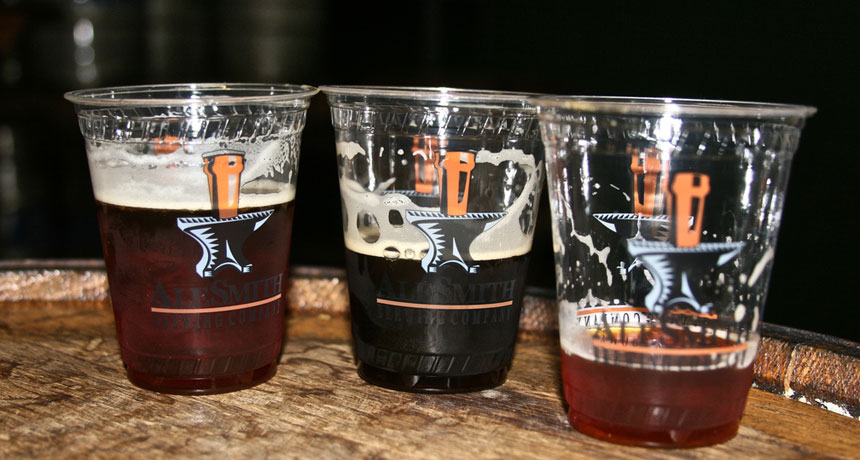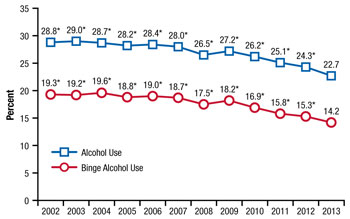Alcohol can rewire the teenage brain
Binge drinking may harm a teen’s brain now — and forever — a mouse study suggests

Warning: Binge drinking can change the brain in ways that make it more difficult to have self-control and not drink later.
Sheila Dee/ Flickr (CC BY-NC-ND 2.0)
By Tara Haelle
Alcohol is a drug. And every day, more than 4,750 American kids aged 15 and younger take their first full drink of this drug. That’s according to the U.S. Substance Abuse and Mental Health Services Administration, or SAMHSA. And the problem is not just that this consumption is illegal. Kids who start drinking before age 15 also are five times more likely to become alcoholics or abuse alcohol than are people who wait until adulthood for their first sip. Another big problem for kids who experiment with this drug is that they are more likely than adults are to consume too much alcohol over a short period of time. This is known as binge drinking.
What few people realize is that binge drinking poses many risks that go well beyond getting drunk and acting irresponsibly. That’s why an organization of doctors has just issued a new report laying out those risks. It appeared in the August 30 issue of Pediatrics.
Lorena Siqueira is a pediatrician at Florida International University and Nicklaus Children’s Hospital in Miami. She studies teen alcohol use and helped write the new Pediatrics report. “When kids drink, they tend to do heavy drinking,” she notes. Unfortunately, she adds, “Their bodies are not ready to handle that kind of alcohol.”
Teens are most likely to binge drink
Some teens drink because they have low self-esteem or think it will make them feel happier, the new Pediatrics report states. Others are impulsive. They are looking for new experiences. Teens also drink when many of their friends do.

In adults, binge drinking means downing at least four drinks in a row, if you’re a woman — five in a row if you’re a man. A drink is one beer, one glass of wine or one shot of hard liquor. For adolescents, it takes less alcohol to constitute a binge. Downing just three drinks in a row is binging for boys 9 to 13 or for any girl under 17. Among boys 14 to 15, it’s four drinks.
More adults drink alcohol than teens do. But among drinkers, teens are more likely than adults to binge, Siqueira notes. Some 28 to 60 percent of teens who drink report binge drinking, she says. Indeed, 9 out of 10 drinks downed by those under age 21 are in a binge-drinking episode, according to the U.S. Centers for Disease Control and Prevention, or CDC.
Teens often start drinking because they are curious and experimenting, Siqueira says. But they tend to drink quickly, “so they take in more than they realize,” she says. Not surprisingly, they can get dangerously drunk very fast.
Plus, “the younger they start, the more likely they are to continue to drink and to drink larger amounts,” Siqueira says. That occurs even though alcohol has a stronger effect in adolescents than it does in adults. The really sad outcome: Teens who binge drink are more likely to become alcoholics, she reports.
Binge drinking is dangerous
“We live in a world where many adults and some teenagers drink alcohol,” says Vivian Faden. She’s a scientist at the National Institute on Alcohol Abuse and Alcoholism, or NIAAA, in Rockville, Md. “So it is normal to be curious about alcohol,” she concedes. But there are good reasons why it makes sense to hold off drinking alcohol “until the teenage years are over,” she says.
Binge drinking leads people to get very drunk. Normally, the liver helps remove alcohol from the blood. But when the liver cannot keep up, the alcohol then circulates through the bloodstream and brain while waiting to be removed by the liver. This is when a person becomes drunk, a condition known as intoxication. About half of high school seniors have been drunk at least once, according to recent research. Some 10 percent of eighth graders have too.
“When you binge drink, you can get into all kinds of trouble,” Siqueira says. Big trouble.
For one, auto accidents. One in every 5 teen drivers involved in fatal car crashes has alcohol in their bloodstream, according to the CDC. More than 80 percent have blood-alcohol levels above the legal limit for adults. But a teen doesn’t have to be behind the wheel for alcohol to pose a grave risk. Teens can get depressed and injure themselves or hurt someone else. They might have sex when they didn’t mean to. A teen might black out, forgetting what happened when he or she was drunk. Some teens drink so much that alcohol poisoning stops them from breathing.
The risks of teen drinking are so high, Siqueira says, that even a single episode may prove to be one too many.
Long-term effects on the brain
People forget what happens when they are drunk because alcohol makes it harder for the brain to turn short-term memories into long-term ones. But for teens, alcohol’s dangers go well beyond impairing memory. A new rodent study finds that alcohol can lead to long-term — and harmful — changes to the brain.
“We used to think that brain development was done by the time you’re a teenager,” Siqueira says. “Now we know that’s not true.” The brain keeps developing into a person’s 20s and even early 30s, she explains.
In the new study, scientists gave 10 doses of alcohol to adolescent rats over 16 days. The amounts led to blood-alcohol levels that might model a binge-drinking teen. After these exposures, the rats never tasted alcohol again. Later, in adulthood, the scientists attached electrical equipment to a part of each animal’s brain. Called the hippocampus, this region controls memory and learning.
Nerve cells in that part of the brain communicated abnormally, the scientists found. The cells also looked more immature than usual. Branches coming off of nerve cells should look like short mushrooms. Instead, here they looked long and thin. Again, this damage showed up in that part of the brain linked with learning and memory.
“For humans, this means binge drinking during adolescence may permanently change brain functioning,” says the NIAAA’s Faden. What’s more, she adds, these changes “appear to be irreversible.”
Mary-Louise Risher of Duke University in Durham, N.C., led that new rodent study. Her team published it in the June issue of Alcoholism: Clinical and Experimental Research.
Other research has shown that teens who drink heavily lose more white matter in their brain over time than do teens who don’t, Faden says. White matter acts a bit like the brain’s superhighway system. It connects areas of the brain’s so-called gray matter, which processes information. The white matter allows messages to shuttle quickly, even over relatively long distances in the brain. Alcohol also can hurt a portion of gray matter in a region known as the prefrontal cortex, Faden says. This area is used for attention, concentration, self-control and making decisions.
Those kinds of skills work together to create what brain scientists refer to as executive function. Poor executive function makes it harder for individuals to control their behavior. And it makes it more difficult for them to stop doing something that know could hurt them. A person with poor executive function may be less likely to turn down the chance to drink alcohol or may get behind the wheel of a car when it would be dangerous to drive.
As alcohol makes a teen less likely to turn down alcohol, the risk of binging grows. This drinking can create a cycle of inappropriate behavior. Worst of all, this cycle may lead to alcoholism in some teens, Faden notes.
The bottom line, she says: When it comes to the developing adolescent brain, “There is no known safe level of binge drinking.”
Power Words
(for more about Power Words, click here)
addiction The uncontrolled use of a habit-forming drug or uncontrolled and unhealthy habit (such as video game playing or phone texting). It results from an illness triggered by brain changes that occur after using some drugs or engaging in some extremely pleasurable activities. People with an addiction will feel a compelling need to use a drug (which can be alcohol, the nicotine in tobacco, a prescription drug or an illegal chemical such as cocaine or heroin), even when the user knows that doing so risks severe health or legal consequences. (For instance, even though 35 million Americans try to quit smoking each year, fewer than 15 out of 100 succeed. Most begin smoking again within a week, according to the National Institute on Drug Abuse.)
adolescence A transitional stage of physical and psychological development that begins at the onset of puberty, typically between the ages of 11 and 13, and ends with adulthood.
alcohol poisoning A serious and potentially deadly condition that occurs when someone drinks a very large amount of alcohol in a short time period. The alcohol can reduce a person’s body temperature. It also can slow a person’s heart rate and breathing until one or both stop. Symptoms include confusion, vomiting, seizures, slow or irregular breathing, pale or blue-colored skin, low body temperature and not being able to wake up.
binge drinking To consume a dangerous amount of alcohol in a short period of time. At a minimum, this would be five servings by an adult within a single day, usually within a short period of time. For teens, it could take far less alcohol to constitute binging.
development (in biology) The growth of an organism from conception through adulthood, often undergoing changes in chemistry, size and sometimes even shape.
electrode (in brain science) Sensors that can pick up electrical activity. (in chemistry) Materials that serve as an anode or cathode, attracting negatively or positively charged particles. Or things that serve as electric conductors through which current leaves or enters something else.
executive function The term that includes all of the brain functions needed for self-regulation, self-control and problem-solving. Executive function requires good working memory to hold several pieces of information in the brain at once. It also includes multi-tasking, prioritizing, reasoning, focus, concentration, goal setting and controlling impulses.
hippocampus A seahorse-shaped region of the brain. It is thought to be the center of emotion, memory and the involuntary nervous system.
intoxicating An adjective to describe something that can cause a sensory high (such as alcohol or certain other drugs) — or an event or condition that can also cause an extremely pleasurable sensation. The “drug” that does this is known as an intoxicant.
long-term memory The brain’s system for storing, maintaining and recalling information from the past.
neuron or nerve cell Any of the impulse-conducting cells that make up the brain, spinal column and nervous system. These specialized cells transmit information to other neurons in the form of electrical signals.
prefrontal cortex A region containing some of the brain’s gray matter. Located behind the forehead, it plays a role in making decisions and other complex mental activities, in emotions and in behaviors.
self esteem How a person collectively views one’s abilities, attractiveness and overall self-worth.
short-term memory (also known as primary memory) The small amount of memory held actively in the mind for a short period of time, such as the series of digits in a telephone number.
white matter One of the two main tissue types found in the brain and spinal cord. It consists mainly of bundles of nerve fibers.







